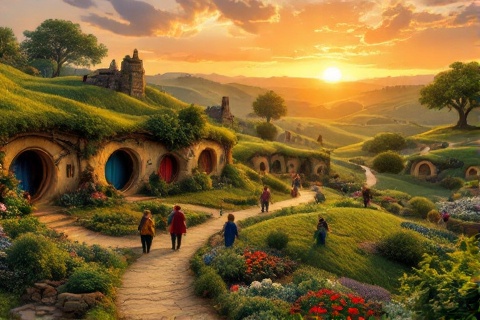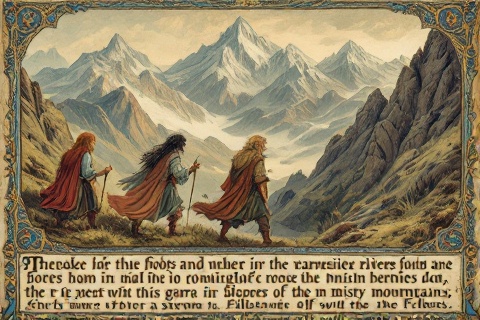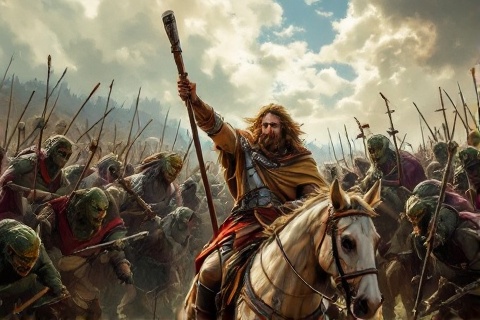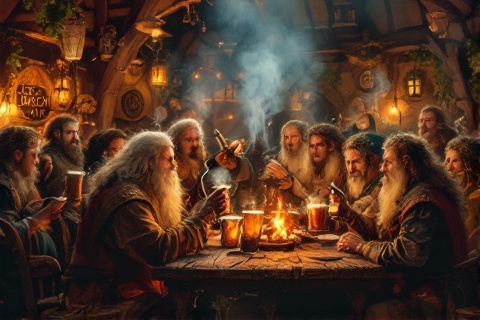
The Secret Lives of Hobbits
Uncovering the Mysteries of the Shire's Most Beloved Folk
Ancient Origins: The Early Days of the Little Folk

The first recorded appearance of hobbits occurred in the vale of
Anduin between the Misty Mountains and
Mirkwood around the year 1050 of the Third
Age. These early hobbits lived alongside the Northmen in the
upper vales of the Great River, establishing their first known settlements in
this fertile region. The records of their origins before this time have been
lost to history, though their awakening likely occurred in the Elder Days.
The hobbits developed into three distinct breeds, each with unique
characteristics and preferences. The Harfoots were the most numerous, being
browner of skin, smaller, and beardless, preferring highlands and hillsides. The
Stoors were broader and heavier, favoring flatlands and riversides, while the
Fallohides were fairer of skin and taller, being lovers of trees and woodland
areas who often took leadership roles among the other breeds.
Around the year 1150 of the Third Age, the hobbits began their momentous
westward migration across the Misty Mountains. This journey was primarily
triggered by the growing darkness in Mirkwood and the increasing presence of
evil creatures in the Anduin Valley. Many crossed the treacherous mountain
passes of the Misty Mountains, though some Stoors temporarily settled in the
angle between the Hoarwell and Loudwater rivers.
The hobbits gradually settled throughout Eriador, with the most significant
event being the founding of the Shire in Third Age 1601. The land was granted to
the hobbits by King Argeleb II of Arthedain, and two brave Fallohide brothers,
Marcho and Blanco, led the migration of hobbits from Bree to establish this new
homeland. The Shire would become the most famous and enduring of all hobbit
settlements, lasting well into the Fourth Age.
Life in the Shire: A Haven of Comfort

Hobbit-holes represent the pinnacle of hobbit architectural ingenuity, featuring
perfectly circular doors painted in cheerful colors, most famously green. These
dwellings extend horizontally into hills or ground, with windows also round,
multiple pantries, and intricate networks of tunnels lined with paneled walls.
The finest examples, such as Bag End, feature high-quality woodwork, tiled
floors, and multiple rooms arranged on one level for maximum comfort.
Gardens hold a special place in hobbit culture, with even the humblest smial
featuring carefully tended flowers and vegetables. The Shire's landscape is
dotted with orchards, flower gardens, and carefully maintained hedgerows.
Hobbits excel at agriculture, producing exceptional crops including the famous
Longbottom Leaf tobacco, various mushroom varieties, and abundant vegetables
that support their hearty appetites.
The eating habits of hobbits are legendary, with seven daily meals being the
norm: breakfast, second breakfast, elevenses, luncheon, afternoon tea, dinner,
and supper. Their cuisine emphasizes comfort foods including mushrooms, bread,
cheese, soups, roasted meats, and preserved fruits. Hobbits take great pride in
their cooking traditions, passing down family recipes through generations and
celebrating special occasions with elaborate feasts.
Social customs among hobbits center around hospitality and celebration, with
birthday parties holding particular significance. Unlike other cultures, hobbit
birthday celebrations involve the birthday person giving gifts to others rather
than receiving them. These parties often feature elaborate feasts, games, and
the distribution of specially selected presents to all guests, with the most
grand celebrations, such as Bilbo's farewell party, becoming part of Shire
legend.
Customs and Character: The Nature of Hobbits
Hobbits typically stand between two and four feet tall, with the average height
being three feet six inches. They are characterized by their pointed ears, large
and hairy feet, and tendency to be somewhat stout. Their lifespan commonly
extends to around 100 years, with some notable hobbits living considerably
longer, such as the Old Took who reached 130 years, though this was considered
exceptional.
The hobbit temperament is marked by a deep love for peace and tranquility,
preferring the simple pleasures of life to grand adventures. They show
remarkable dedication to cultivating the earth, taking great satisfaction in
growing things and maintaining their lands. This connection to the soil and
preference for quiet living has shaped their society and culture throughout
their history.
Gift-giving forms a central part of hobbit culture, with a unique tradition of
storing and redistributing presents through mathom-houses. These buildings serve
as museums and storage facilities for items that are frequently regifted, as
hobbits prefer to give away rather than throw away possessions. Many of these
mathoms are objects of questionable utility but significant sentimental or
historical value.
Hobbits demonstrate an innate resistance to evil influences, showing remarkable
resilience against the corrupting power of the One Ring
compared to other races. This natural immunity stems from their simple desires
and lack of ambition for power or dominion over others. Their contentment with
life's basic pleasures and strong sense of right and wrong serve as a natural
defense against darkness.
Social Structure and Government

The Thain and the Mayor of Michel Delving serve as the two principal officials
in the Shire's governance structure. The Thain, traditionally chosen from the
Took family, acts as the military leader and head of the Shire-moot, while the
Mayor oversees the Messenger Service, the Watch, and various ceremonial duties.
These positions reflect the hobbits' preference for minimal but practical
governance.
Family relationships and genealogy hold immense importance in hobbit society,
with extensive family trees maintained and memorized across generations. The
most prominent families, such as the Tooks, Brandybucks, and Baggins, maintain
detailed records of their lineages. Family connections influence social
standing, property inheritance, and even living arrangements within the Shire.
The Shire-moot and Shire-muster systems represent the civic and military
organization of the Shire. The Shire-moot serves as a gathering for urgent
matters affecting the entire region, while the Shire-muster organizes the hobbit
militia during rare emergencies. These institutions remained largely ceremonial
during peaceful times but proved vital during crises such as the Battle of
Bywater.
Law enforcement in the Shire primarily falls to the Bounders, who patrol the
borders and maintain order. These officials ensure that both outsiders and
residents follow the Rules, as hobbits call their laws. The Shirriffs, marked by
feathers in their caps, serve as a small police force handling minor
infractions, though serious crimes are rare in hobbit society.
Relations with the Outside World
The hobbits maintained historical ties with the Dúnedain of the North since
their settlement in Eriador, particularly through the Kings of Arnor who granted
them the Shire lands. These relationships, though largely forgotten by the time
of the War of the Ring, formed the foundation of the hobbits' autonomy and their
special place in the Northern Kingdom.
Trade relations flourished between hobbits and their neighbors, particularly
with the Dwarves traveling on the East Road and the Men of
Bree. The Shire exported agricultural products, including pipe-weed
and fine cloth, while importing tools, metals, and luxury items. The Bree-land
served as an important trading hub where hobbits and Men lived in rare
cooperation.
Hobbits maintain a natural skepticism toward the Big Folk and unusual
occurrences, preferring to avoid involvement in the affairs of the outside
world. This wariness stems from historical experiences and their preference for
predictability and routine. They often dismiss tales of strange happenings
beyond their borders as disturbing and unwelcome interruptions to their ordered
lives.
The Rangers of the North, unknown to most hobbits, provided crucial protection
to the Shire for generations. These descendants of the Dúnedain patrolled the
borders and kept evil at bay, allowing the hobbits to maintain their peaceful
way of life. This secret guardianship lasted until the return of King
Elessar, when their role was finally revealed
and honored.
Notable Achievements and Heroes

Bandobras 'Bullroarer' Took earned his legendary status during the Battle of
Greenfields in 1147 of the Shire Reckoning. Standing four foot five and able to
ride a horse, he led the hobbits to victory against an invasion of
Orcs from Mount Gram, personally slaying their leader Golfimbul
with a club blow that sent the Orc's head flying through the air and into a
rabbit hole, supposedly inventing the game of golf simultaneously.
Bilbo Baggins transformed hobbit society through his
famous adventure and subsequent influence on Shire culture. His translations of
Elvish texts, collection of stories, and wealth of knowledge from his travels
enriched the intellectual life of the Shire. Additionally, his adoption of
Frodo and unconventional lifestyle challenged
traditional hobbit social norms.
The hobbits played a crucial role in the War of the Ring, with Frodo Baggins,
Samwise Gamgee, Peregrin Took, and Meriadoc
Brandybuck each contributing significantly to the downfall of
Sauron. Their participation demonstrated that even the
smallest individuals could affect the fate of
Middle-earth, proving Gandalf's
wisdom in trusting these seemingly insignificant folk with great tasks.
The Four Travelers, as they became known after their return, brought significant
changes to the Shire following the War of the Ring. Sam used
Galadriel's gift to restore the Shire's devastated
landscapes, while Merry and Pippin introduced new customs and knowledge from
Rohan and Gondor. Their experiences and leadership helped usher
the Shire into the Fourth Age while preserving its essential character.
Arts, Learning, and Entertainment

Oral traditions form the backbone of hobbit cultural preservation, with stories
passed down through generations during family gatherings and celebrations. Tales
of notable ancestors, historical events, and family legends are shared
regularly, maintaining a strong connection to their heritage while entertaining
young and old alike.
Hobbits possess a rich tradition of songs and poetry, ranging from lighthearted
drinking songs to complex verses about historical events. Their love of riddles,
demonstrated in Bilbo's encounter with Gollum, reflects
their appreciation for wordplay and mental challenges. These verbal arts often
combine entertainment with the preservation of historical knowledge.
The Red Book of Westmarch stands as the most important written record of hobbit
history, containing accounts of the War of the Ring, Bilbo's journey, and
various historical notes. Originally begun by Bilbo and continued by Frodo and
Sam, this manuscript became the foundation for later works including 'The
Hobbit' and 'The Lord of the Rings', preserving the most significant events of
the Third Age.
Hobbit festivals mark the passage of the year with numerous celebrations
including Lithe, Yule, and various harvest festivals. These gatherings feature
traditional foods, music, dancing, and storytelling, strengthening community
bonds and maintaining cultural traditions. The Mid-year's Day celebration holds
particular significance, often featuring grand parties and feasts.
Legacy in Middle-earth
Hobbits proved instrumental in the history of Middle-earth despite their small
stature and seeming insignificance. Their role in the destruction of the One
Ring demonstrated that the fate of great matters often rests in the hands of
those deemed least important by the wise. This truth fulfilled Gandalf's insight
that the small hands of hobbits would move the wheels of the world.
The strength of hobbits lies not in physical power or magical abilities, but in
their resilience, loyalty, and uncomplicated wisdom. Their resistance to
corruption, demonstrated most notably by Frodo and Sam's quest to
Mordor, proved that inner strength often surpasses external
might. This lesson resonates throughout Tolkien's works as a central theme.
As the Fourth Age dawned, the connection between hobbits and the outside world
gradually diminished. While some, like Peregrin's and Meriadoc's descendants,
maintained contact with Gondor and Rohan, most hobbits returned to their
traditional isolated lifestyle. The Shire remained a protected enclave under
King Elessar's decree, preserving their unique culture while the world around
them transformed.
